Analyzing Financial Management's Role in Employee Wellbeing at TESCO
VerifiedAdded on 2023/06/12
|13
|4249
|315
Report
AI Summary
This report proposal investigates the significance of financial wellbeing for employees, focusing on TESCO as a case study. It aims to understand the importance of financial wellbeing, evaluate its impacts on employees, analyze the influence of COVID-19, and determine effective strategies for implementation. The research questions explore the importance, impacts, and actions related to financial wellbeing, as well as the influence of COVID-19. The rationale emphasizes the need for financial management to address employee stress, particularly in uncertain times. The scope covers the psychological and analytical aspects of financial wellbeing, highlighting its contribution to personal goals and productivity. The literature review covers the concept of financial wellbeing, its relationship with employee efficiency, the impact of COVID-19, and tools for implementation. Research methodologies including research type, approach, philosophy, data collection, sampling, and analysis are mentioned. The report concludes by emphasizing the direct relationship between financial wellbeing and the personal and professional lives of employees, highlighting the importance of financial security in managing crises and enhancing productivity.

Financial management on
employees
employees
Paraphrase This Document
Need a fresh take? Get an instant paraphrase of this document with our AI Paraphraser
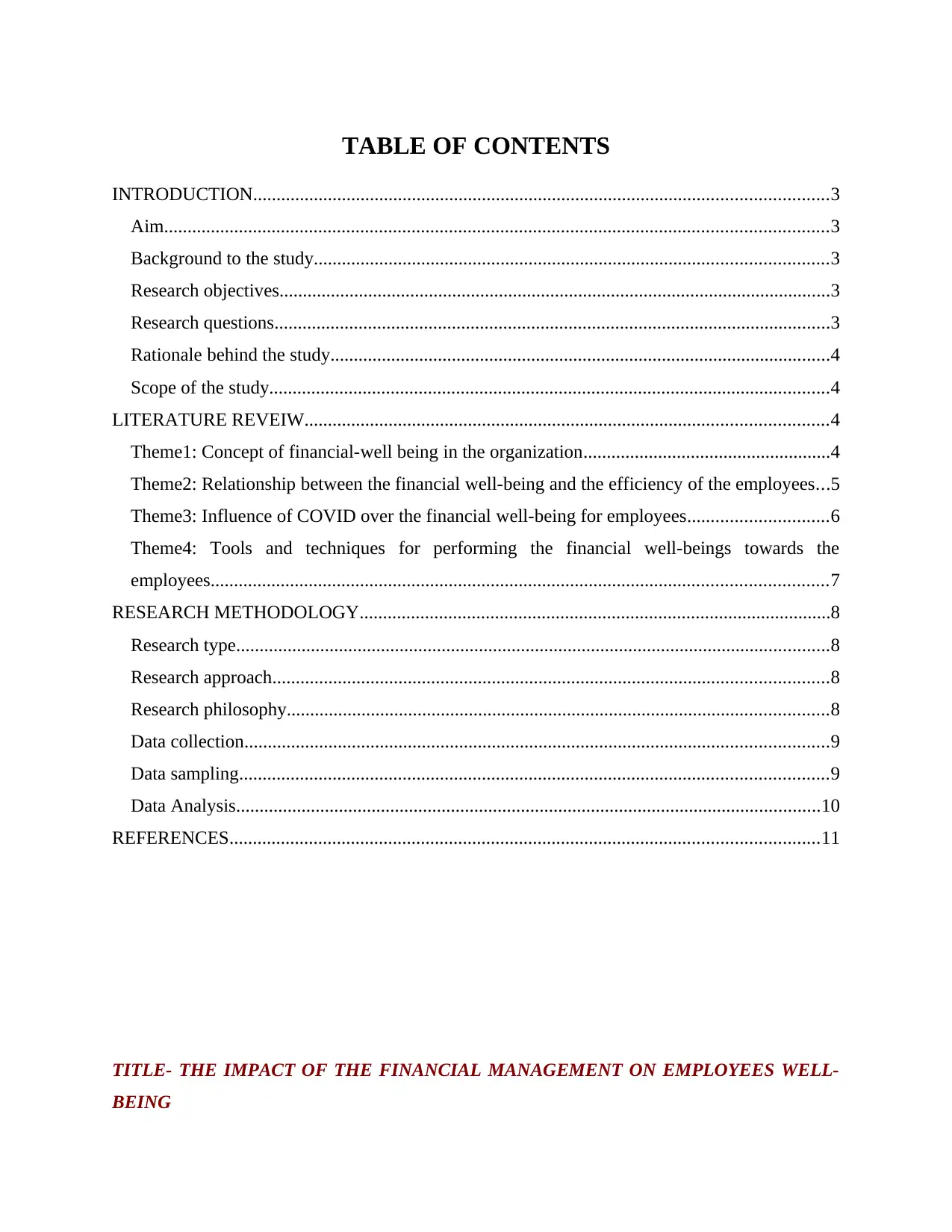
TABLE OF CONTENTS
INTRODUCTION...........................................................................................................................3
Aim..............................................................................................................................................3
Background to the study..............................................................................................................3
Research objectives......................................................................................................................3
Research questions.......................................................................................................................3
Rationale behind the study...........................................................................................................4
Scope of the study........................................................................................................................4
LITERATURE REVEIW................................................................................................................4
Theme1: Concept of financial-well being in the organization.....................................................4
Theme2: Relationship between the financial well-being and the efficiency of the employees...5
Theme3: Influence of COVID over the financial well-being for employees..............................6
Theme4: Tools and techniques for performing the financial well-beings towards the
employees....................................................................................................................................7
RESEARCH METHODOLOGY.....................................................................................................8
Research type...............................................................................................................................8
Research approach.......................................................................................................................8
Research philosophy....................................................................................................................8
Data collection.............................................................................................................................9
Data sampling..............................................................................................................................9
Data Analysis.............................................................................................................................10
REFERENCES..............................................................................................................................11
TITLE- THE IMPACT OF THE FINANCIAL MANAGEMENT ON EMPLOYEES WELL-
BEING
INTRODUCTION...........................................................................................................................3
Aim..............................................................................................................................................3
Background to the study..............................................................................................................3
Research objectives......................................................................................................................3
Research questions.......................................................................................................................3
Rationale behind the study...........................................................................................................4
Scope of the study........................................................................................................................4
LITERATURE REVEIW................................................................................................................4
Theme1: Concept of financial-well being in the organization.....................................................4
Theme2: Relationship between the financial well-being and the efficiency of the employees...5
Theme3: Influence of COVID over the financial well-being for employees..............................6
Theme4: Tools and techniques for performing the financial well-beings towards the
employees....................................................................................................................................7
RESEARCH METHODOLOGY.....................................................................................................8
Research type...............................................................................................................................8
Research approach.......................................................................................................................8
Research philosophy....................................................................................................................8
Data collection.............................................................................................................................9
Data sampling..............................................................................................................................9
Data Analysis.............................................................................................................................10
REFERENCES..............................................................................................................................11
TITLE- THE IMPACT OF THE FINANCIAL MANAGEMENT ON EMPLOYEES WELL-
BEING
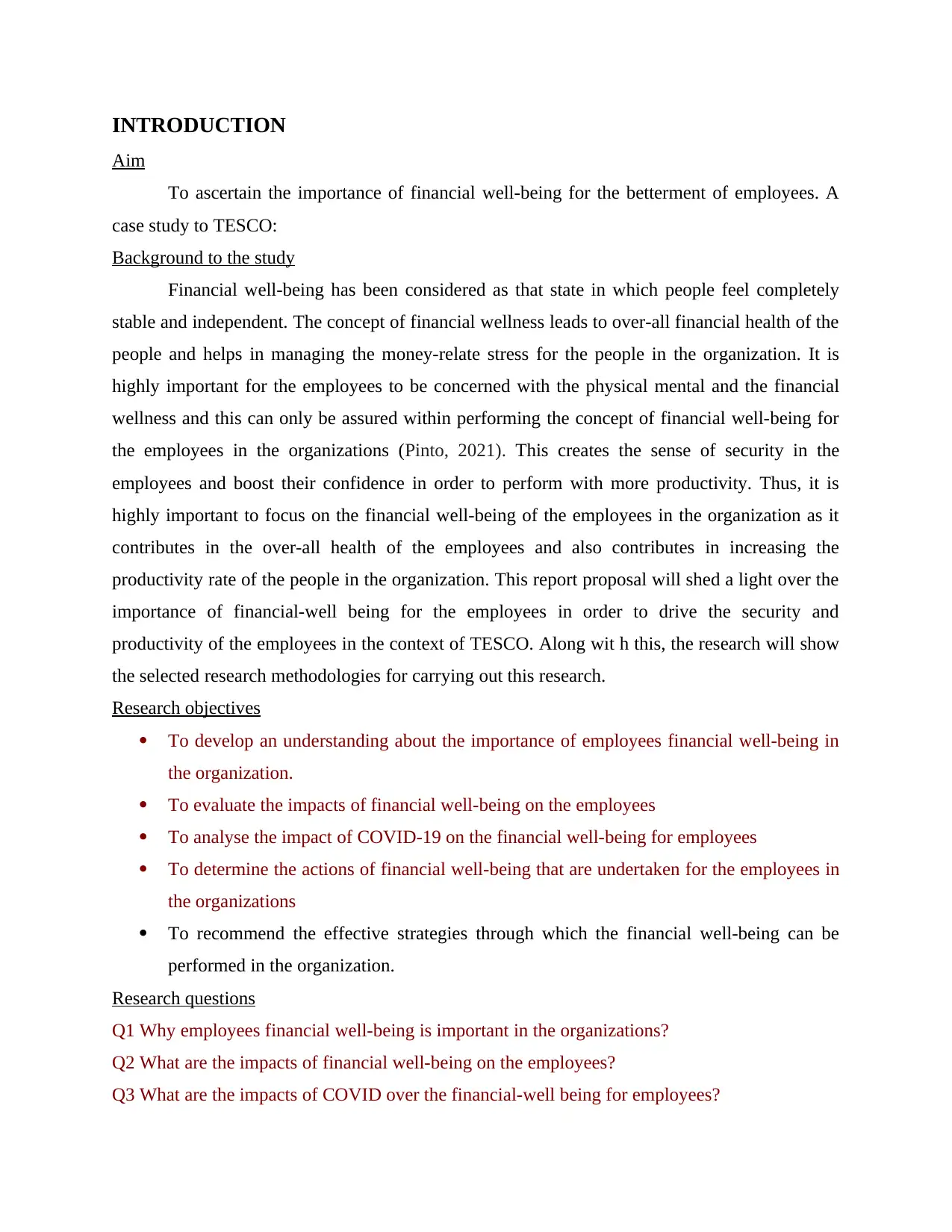
INTRODUCTION
Aim
To ascertain the importance of financial well-being for the betterment of employees. A
case study to TESCO:
Background to the study
Financial well-being has been considered as that state in which people feel completely
stable and independent. The concept of financial wellness leads to over-all financial health of the
people and helps in managing the money-relate stress for the people in the organization. It is
highly important for the employees to be concerned with the physical mental and the financial
wellness and this can only be assured within performing the concept of financial well-being for
the employees in the organizations (Pinto, 2021). This creates the sense of security in the
employees and boost their confidence in order to perform with more productivity. Thus, it is
highly important to focus on the financial well-being of the employees in the organization as it
contributes in the over-all health of the employees and also contributes in increasing the
productivity rate of the people in the organization. This report proposal will shed a light over the
importance of financial-well being for the employees in order to drive the security and
productivity of the employees in the context of TESCO. Along wit h this, the research will show
the selected research methodologies for carrying out this research.
Research objectives
To develop an understanding about the importance of employees financial well-being in
the organization.
To evaluate the impacts of financial well-being on the employees
To analyse the impact of COVID-19 on the financial well-being for employees
To determine the actions of financial well-being that are undertaken for the employees in
the organizations
To recommend the effective strategies through which the financial well-being can be
performed in the organization.
Research questions
Q1 Why employees financial well-being is important in the organizations?
Q2 What are the impacts of financial well-being on the employees?
Q3 What are the impacts of COVID over the financial-well being for employees?
Aim
To ascertain the importance of financial well-being for the betterment of employees. A
case study to TESCO:
Background to the study
Financial well-being has been considered as that state in which people feel completely
stable and independent. The concept of financial wellness leads to over-all financial health of the
people and helps in managing the money-relate stress for the people in the organization. It is
highly important for the employees to be concerned with the physical mental and the financial
wellness and this can only be assured within performing the concept of financial well-being for
the employees in the organizations (Pinto, 2021). This creates the sense of security in the
employees and boost their confidence in order to perform with more productivity. Thus, it is
highly important to focus on the financial well-being of the employees in the organization as it
contributes in the over-all health of the employees and also contributes in increasing the
productivity rate of the people in the organization. This report proposal will shed a light over the
importance of financial-well being for the employees in order to drive the security and
productivity of the employees in the context of TESCO. Along wit h this, the research will show
the selected research methodologies for carrying out this research.
Research objectives
To develop an understanding about the importance of employees financial well-being in
the organization.
To evaluate the impacts of financial well-being on the employees
To analyse the impact of COVID-19 on the financial well-being for employees
To determine the actions of financial well-being that are undertaken for the employees in
the organizations
To recommend the effective strategies through which the financial well-being can be
performed in the organization.
Research questions
Q1 Why employees financial well-being is important in the organizations?
Q2 What are the impacts of financial well-being on the employees?
Q3 What are the impacts of COVID over the financial-well being for employees?
⊘ This is a preview!⊘
Do you want full access?
Subscribe today to unlock all pages.

Trusted by 1+ million students worldwide
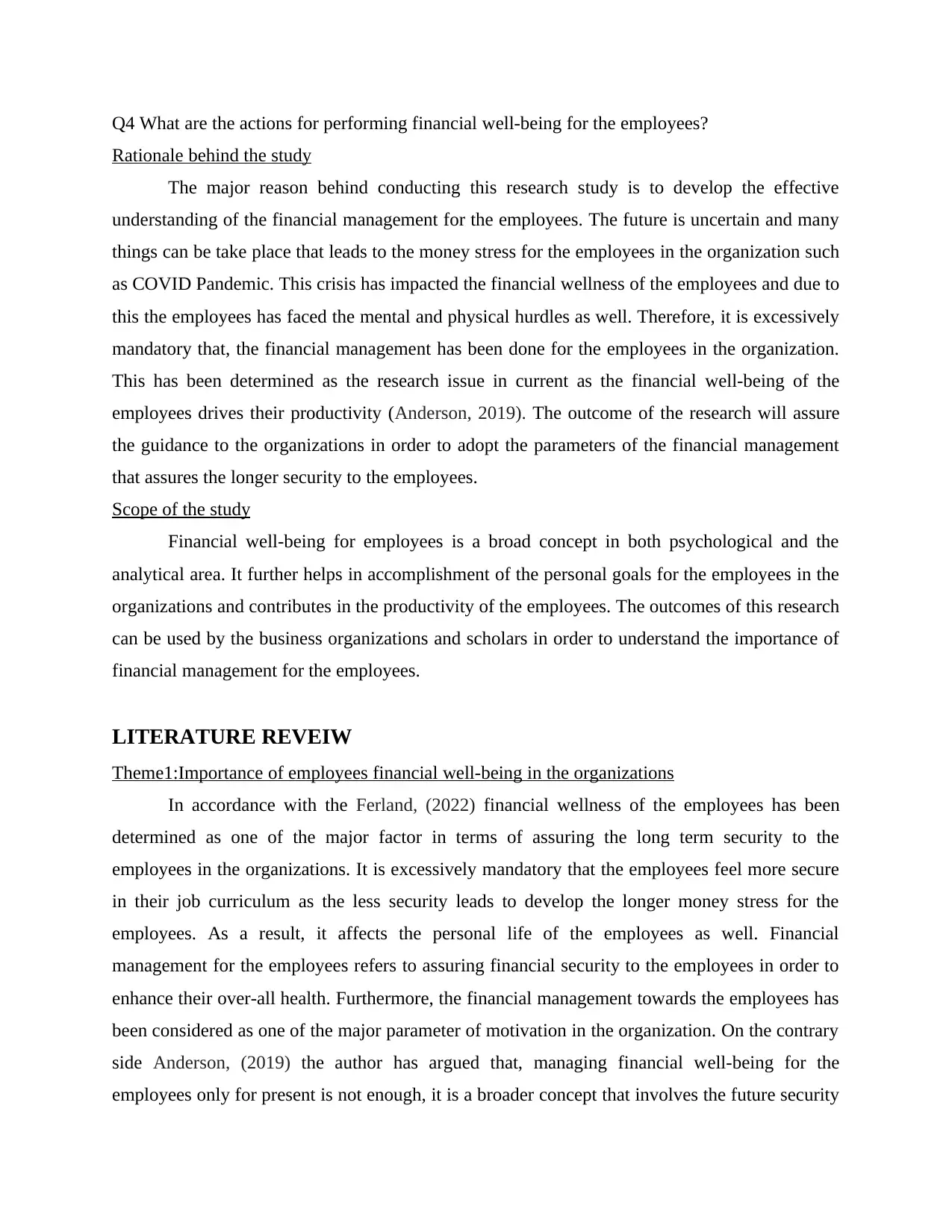
Q4 What are the actions for performing financial well-being for the employees?
Rationale behind the study
The major reason behind conducting this research study is to develop the effective
understanding of the financial management for the employees. The future is uncertain and many
things can be take place that leads to the money stress for the employees in the organization such
as COVID Pandemic. This crisis has impacted the financial wellness of the employees and due to
this the employees has faced the mental and physical hurdles as well. Therefore, it is excessively
mandatory that, the financial management has been done for the employees in the organization.
This has been determined as the research issue in current as the financial well-being of the
employees drives their productivity (Anderson, 2019). The outcome of the research will assure
the guidance to the organizations in order to adopt the parameters of the financial management
that assures the longer security to the employees.
Scope of the study
Financial well-being for employees is a broad concept in both psychological and the
analytical area. It further helps in accomplishment of the personal goals for the employees in the
organizations and contributes in the productivity of the employees. The outcomes of this research
can be used by the business organizations and scholars in order to understand the importance of
financial management for the employees.
LITERATURE REVEIW
Theme1:Importance of employees financial well-being in the organizations
In accordance with the Ferland, (2022) financial wellness of the employees has been
determined as one of the major factor in terms of assuring the long term security to the
employees in the organizations. It is excessively mandatory that the employees feel more secure
in their job curriculum as the less security leads to develop the longer money stress for the
employees. As a result, it affects the personal life of the employees as well. Financial
management for the employees refers to assuring financial security to the employees in order to
enhance their over-all health. Furthermore, the financial management towards the employees has
been considered as one of the major parameter of motivation in the organization. On the contrary
side Anderson, (2019) the author has argued that, managing financial well-being for the
employees only for present is not enough, it is a broader concept that involves the future security
Rationale behind the study
The major reason behind conducting this research study is to develop the effective
understanding of the financial management for the employees. The future is uncertain and many
things can be take place that leads to the money stress for the employees in the organization such
as COVID Pandemic. This crisis has impacted the financial wellness of the employees and due to
this the employees has faced the mental and physical hurdles as well. Therefore, it is excessively
mandatory that, the financial management has been done for the employees in the organization.
This has been determined as the research issue in current as the financial well-being of the
employees drives their productivity (Anderson, 2019). The outcome of the research will assure
the guidance to the organizations in order to adopt the parameters of the financial management
that assures the longer security to the employees.
Scope of the study
Financial well-being for employees is a broad concept in both psychological and the
analytical area. It further helps in accomplishment of the personal goals for the employees in the
organizations and contributes in the productivity of the employees. The outcomes of this research
can be used by the business organizations and scholars in order to understand the importance of
financial management for the employees.
LITERATURE REVEIW
Theme1:Importance of employees financial well-being in the organizations
In accordance with the Ferland, (2022) financial wellness of the employees has been
determined as one of the major factor in terms of assuring the long term security to the
employees in the organizations. It is excessively mandatory that the employees feel more secure
in their job curriculum as the less security leads to develop the longer money stress for the
employees. As a result, it affects the personal life of the employees as well. Financial
management for the employees refers to assuring financial security to the employees in order to
enhance their over-all health. Furthermore, the financial management towards the employees has
been considered as one of the major parameter of motivation in the organization. On the contrary
side Anderson, (2019) the author has argued that, managing financial well-being for the
employees only for present is not enough, it is a broader concept that involves the future security
Paraphrase This Document
Need a fresh take? Get an instant paraphrase of this document with our AI Paraphraser
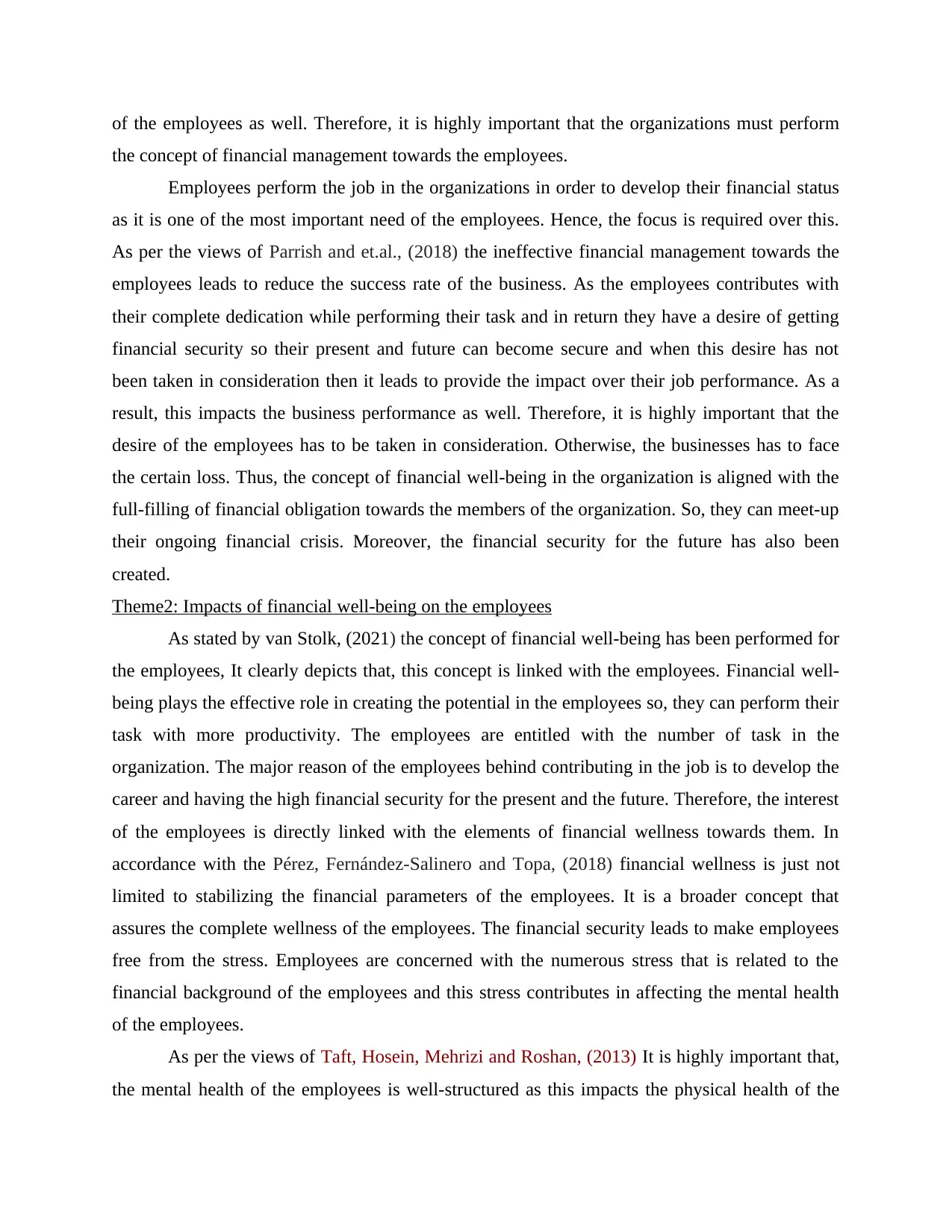
of the employees as well. Therefore, it is highly important that the organizations must perform
the concept of financial management towards the employees.
Employees perform the job in the organizations in order to develop their financial status
as it is one of the most important need of the employees. Hence, the focus is required over this.
As per the views of Parrish and et.al., (2018) the ineffective financial management towards the
employees leads to reduce the success rate of the business. As the employees contributes with
their complete dedication while performing their task and in return they have a desire of getting
financial security so their present and future can become secure and when this desire has not
been taken in consideration then it leads to provide the impact over their job performance. As a
result, this impacts the business performance as well. Therefore, it is highly important that the
desire of the employees has to be taken in consideration. Otherwise, the businesses has to face
the certain loss. Thus, the concept of financial well-being in the organization is aligned with the
full-filling of financial obligation towards the members of the organization. So, they can meet-up
their ongoing financial crisis. Moreover, the financial security for the future has also been
created.
Theme2: Impacts of financial well-being on the employees
As stated by van Stolk, (2021) the concept of financial well-being has been performed for
the employees, It clearly depicts that, this concept is linked with the employees. Financial well-
being plays the effective role in creating the potential in the employees so, they can perform their
task with more productivity. The employees are entitled with the number of task in the
organization. The major reason of the employees behind contributing in the job is to develop the
career and having the high financial security for the present and the future. Therefore, the interest
of the employees is directly linked with the elements of financial wellness towards them. In
accordance with the Pérez, Fernández-Salinero and Topa, (2018) financial wellness is just not
limited to stabilizing the financial parameters of the employees. It is a broader concept that
assures the complete wellness of the employees. The financial security leads to make employees
free from the stress. Employees are concerned with the numerous stress that is related to the
financial background of the employees and this stress contributes in affecting the mental health
of the employees.
As per the views of Taft, Hosein, Mehrizi and Roshan, (2013) It is highly important that,
the mental health of the employees is well-structured as this impacts the physical health of the
the concept of financial management towards the employees.
Employees perform the job in the organizations in order to develop their financial status
as it is one of the most important need of the employees. Hence, the focus is required over this.
As per the views of Parrish and et.al., (2018) the ineffective financial management towards the
employees leads to reduce the success rate of the business. As the employees contributes with
their complete dedication while performing their task and in return they have a desire of getting
financial security so their present and future can become secure and when this desire has not
been taken in consideration then it leads to provide the impact over their job performance. As a
result, this impacts the business performance as well. Therefore, it is highly important that the
desire of the employees has to be taken in consideration. Otherwise, the businesses has to face
the certain loss. Thus, the concept of financial well-being in the organization is aligned with the
full-filling of financial obligation towards the members of the organization. So, they can meet-up
their ongoing financial crisis. Moreover, the financial security for the future has also been
created.
Theme2: Impacts of financial well-being on the employees
As stated by van Stolk, (2021) the concept of financial well-being has been performed for
the employees, It clearly depicts that, this concept is linked with the employees. Financial well-
being plays the effective role in creating the potential in the employees so, they can perform their
task with more productivity. The employees are entitled with the number of task in the
organization. The major reason of the employees behind contributing in the job is to develop the
career and having the high financial security for the present and the future. Therefore, the interest
of the employees is directly linked with the elements of financial wellness towards them. In
accordance with the Pérez, Fernández-Salinero and Topa, (2018) financial wellness is just not
limited to stabilizing the financial parameters of the employees. It is a broader concept that
assures the complete wellness of the employees. The financial security leads to make employees
free from the stress. Employees are concerned with the numerous stress that is related to the
financial background of the employees and this stress contributes in affecting the mental health
of the employees.
As per the views of Taft, Hosein, Mehrizi and Roshan, (2013) It is highly important that,
the mental health of the employees is well-structured as this impacts the physical health of the

employees as well. Issues related to the money stress leads to develop the anxiety and depression
in the employees. Thus, it starts impacting the personal lives of the employees as well. The
ineffective life structure has been developed for the employees in which they do not make
effective contribution in their personal and professional life as well. This is how the financial
well-being is directly linked with the betterment of the employees. The concept of financial
wellness creates the higher sense of security among the employees in regards to their present and
the future. In accordance with the Alshebami, (2021) financial management of the employees
direct impacts the working procedure of the employees in the organizations. The sense of
becoming financially independent leads to develop the confidence in the employees. The higher
rate of confidence creates the effective desire of performing the job with more potential. As a
result, it enables the organization in terms of achieving the higher rate of success. Thus, the
financial well- being is directly related to the employees as it shaped the personal and the
professional lives of the employees.
Theme3: Influence of COVID over the financial well-being for employees
Financial wellness of the employees works as a support system for the employees in
order to meet up with the financial crisis. The effective strategies is required by the organizations
so, the future of the employees can be secure especially at the time of uncertainty. As per the
views of Netemeyer and et.al., (2018) COVID pandemic is one of the biggest crisis hat has
impacted the financial well-being of the employees. Furthermore, the pandemic has opened the
eyes of the organizations in terms of performing the financial management for the employees. At
the time of pandemic the employees has faced the numerous number of financial crisis. The
people were fighting with the pandemic and along with this, the financial crisis has also been
bear by them. Also, many employees has lost their job during pandemic. As a result, this has
created the heavy impact over the lives of the employees. Therefore, assuring financial security
to the employees is highly important as it helps them to deal with the financial crisis.
As stated by Goyal and Kumar, (2021) pandemic has become the major point from where
the decision regarding the financial well-being of the employees has been started taking in
consideration. At the time of pandemic, people were facing the stress of this pandemic already
and many of the employees are not entitled with the financial security in terms of dealing with
the pandemic. On the contrary side Dicu, Rybnikova and Steger, (2022) has argued that, the
workers who are mainly labours in the organizations has not given the right of experiencing
in the employees. Thus, it starts impacting the personal lives of the employees as well. The
ineffective life structure has been developed for the employees in which they do not make
effective contribution in their personal and professional life as well. This is how the financial
well-being is directly linked with the betterment of the employees. The concept of financial
wellness creates the higher sense of security among the employees in regards to their present and
the future. In accordance with the Alshebami, (2021) financial management of the employees
direct impacts the working procedure of the employees in the organizations. The sense of
becoming financially independent leads to develop the confidence in the employees. The higher
rate of confidence creates the effective desire of performing the job with more potential. As a
result, it enables the organization in terms of achieving the higher rate of success. Thus, the
financial well- being is directly related to the employees as it shaped the personal and the
professional lives of the employees.
Theme3: Influence of COVID over the financial well-being for employees
Financial wellness of the employees works as a support system for the employees in
order to meet up with the financial crisis. The effective strategies is required by the organizations
so, the future of the employees can be secure especially at the time of uncertainty. As per the
views of Netemeyer and et.al., (2018) COVID pandemic is one of the biggest crisis hat has
impacted the financial well-being of the employees. Furthermore, the pandemic has opened the
eyes of the organizations in terms of performing the financial management for the employees. At
the time of pandemic the employees has faced the numerous number of financial crisis. The
people were fighting with the pandemic and along with this, the financial crisis has also been
bear by them. Also, many employees has lost their job during pandemic. As a result, this has
created the heavy impact over the lives of the employees. Therefore, assuring financial security
to the employees is highly important as it helps them to deal with the financial crisis.
As stated by Goyal and Kumar, (2021) pandemic has become the major point from where
the decision regarding the financial well-being of the employees has been started taking in
consideration. At the time of pandemic, people were facing the stress of this pandemic already
and many of the employees are not entitled with the financial security in terms of dealing with
the pandemic. On the contrary side Dicu, Rybnikova and Steger, (2022) has argued that, the
workers who are mainly labours in the organizations has not given the right of experiencing
⊘ This is a preview!⊘
Do you want full access?
Subscribe today to unlock all pages.

Trusted by 1+ million students worldwide

financial wellness. At the time of COVID many workers adopted the path of suicide as they were
in a big trouble. Thus, the COVID has impacted the decision of financial well-being for the
employees and for the labours as well. It is important to introduce the finance security policy for
the labours as well as they are the part of the organization so, they can deal with such crisis.
Thus, the COVID has impacted the financial security of the employees and created the numerous
financial crisis for the employees. Therefore, it is mandatory that the organizations must focus on
the financial well-being of the employees so, their present and future can become secure and at
the time of uncertainty the situation can be managed.
Theme4: Actions for performing the financial well-beings towards the employees
As per the views of Young and et.al., (2018) it has been stated that, it is mandatory to use
the appropriate tools and techniques for assuring the financial well-being of the employees in the
organizations. It is important to know the needs and wants of the employees regarding the
financial management. Employees financial wellness starts within assessing the needs of the
employees. Afterwards, the support has to be build by the organizations for the employees and
the actions has to be taken in order to ensure that the needs of the employees has been full-filled.
In accordance with the Charalampous and et.al., (2019) in an organization there are large number
of employees who performs the job, some are among the age of 20-40 and some are above 40.
The needs and requirement of all the employees related to the financial well-being is different
therefore, different tools has to be adopted for the employees. In order to secure the future of the
employees EPF policy has to be adopted by the organizations. At the time of retirement of the
employees this fund has to be given to them so, there future can be secure.
In accordance with the Zemtsov and Osipova, (2016) The facilities regarding the medical
insurance, child voucher, has to be assured by the organizations so, the employees can have the
sense of higher security and can live stress free life. Also, the focus has to be made by the
organizations over the threats related to the break of salary. The policies regarding the paying has
to be monitored and the changes has to be made in them within the changing pace of time. The
payment scheme of the employees has to be increased. A fix rate of increment has to be decided
by the organizations and the pay skills has to be decided by them. As stated by Johnson and
et.al., (2018) one of the vital element for performing the financial well-being towards the
employees is to assure the job security to the employees. Job security assures the long-term
financial security for the employees and enables them to have more confidence in the favour of
in a big trouble. Thus, the COVID has impacted the decision of financial well-being for the
employees and for the labours as well. It is important to introduce the finance security policy for
the labours as well as they are the part of the organization so, they can deal with such crisis.
Thus, the COVID has impacted the financial security of the employees and created the numerous
financial crisis for the employees. Therefore, it is mandatory that the organizations must focus on
the financial well-being of the employees so, their present and future can become secure and at
the time of uncertainty the situation can be managed.
Theme4: Actions for performing the financial well-beings towards the employees
As per the views of Young and et.al., (2018) it has been stated that, it is mandatory to use
the appropriate tools and techniques for assuring the financial well-being of the employees in the
organizations. It is important to know the needs and wants of the employees regarding the
financial management. Employees financial wellness starts within assessing the needs of the
employees. Afterwards, the support has to be build by the organizations for the employees and
the actions has to be taken in order to ensure that the needs of the employees has been full-filled.
In accordance with the Charalampous and et.al., (2019) in an organization there are large number
of employees who performs the job, some are among the age of 20-40 and some are above 40.
The needs and requirement of all the employees related to the financial well-being is different
therefore, different tools has to be adopted for the employees. In order to secure the future of the
employees EPF policy has to be adopted by the organizations. At the time of retirement of the
employees this fund has to be given to them so, there future can be secure.
In accordance with the Zemtsov and Osipova, (2016) The facilities regarding the medical
insurance, child voucher, has to be assured by the organizations so, the employees can have the
sense of higher security and can live stress free life. Also, the focus has to be made by the
organizations over the threats related to the break of salary. The policies regarding the paying has
to be monitored and the changes has to be made in them within the changing pace of time. The
payment scheme of the employees has to be increased. A fix rate of increment has to be decided
by the organizations and the pay skills has to be decided by them. As stated by Johnson and
et.al., (2018) one of the vital element for performing the financial well-being towards the
employees is to assure the job security to the employees. Job security assures the long-term
financial security for the employees and enables them to have more confidence in the favour of
Paraphrase This Document
Need a fresh take? Get an instant paraphrase of this document with our AI Paraphraser
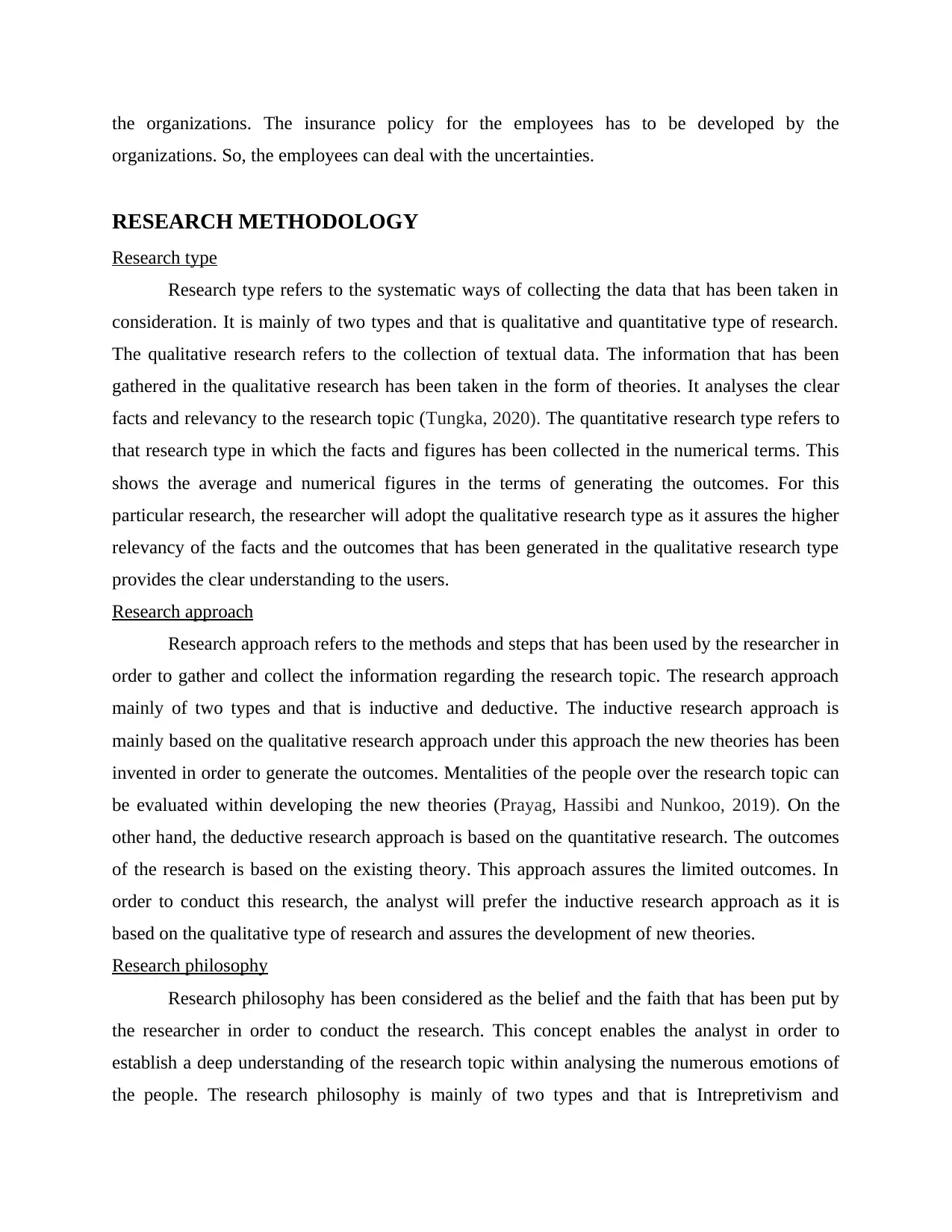
the organizations. The insurance policy for the employees has to be developed by the
organizations. So, the employees can deal with the uncertainties.
RESEARCH METHODOLOGY
Research type
Research type refers to the systematic ways of collecting the data that has been taken in
consideration. It is mainly of two types and that is qualitative and quantitative type of research.
The qualitative research refers to the collection of textual data. The information that has been
gathered in the qualitative research has been taken in the form of theories. It analyses the clear
facts and relevancy to the research topic (Tungka, 2020). The quantitative research type refers to
that research type in which the facts and figures has been collected in the numerical terms. This
shows the average and numerical figures in the terms of generating the outcomes. For this
particular research, the researcher will adopt the qualitative research type as it assures the higher
relevancy of the facts and the outcomes that has been generated in the qualitative research type
provides the clear understanding to the users.
Research approach
Research approach refers to the methods and steps that has been used by the researcher in
order to gather and collect the information regarding the research topic. The research approach
mainly of two types and that is inductive and deductive. The inductive research approach is
mainly based on the qualitative research approach under this approach the new theories has been
invented in order to generate the outcomes. Mentalities of the people over the research topic can
be evaluated within developing the new theories (Prayag, Hassibi and Nunkoo, 2019). On the
other hand, the deductive research approach is based on the quantitative research. The outcomes
of the research is based on the existing theory. This approach assures the limited outcomes. In
order to conduct this research, the analyst will prefer the inductive research approach as it is
based on the qualitative type of research and assures the development of new theories.
Research philosophy
Research philosophy has been considered as the belief and the faith that has been put by
the researcher in order to conduct the research. This concept enables the analyst in order to
establish a deep understanding of the research topic within analysing the numerous emotions of
the people. The research philosophy is mainly of two types and that is Intrepretivism and
organizations. So, the employees can deal with the uncertainties.
RESEARCH METHODOLOGY
Research type
Research type refers to the systematic ways of collecting the data that has been taken in
consideration. It is mainly of two types and that is qualitative and quantitative type of research.
The qualitative research refers to the collection of textual data. The information that has been
gathered in the qualitative research has been taken in the form of theories. It analyses the clear
facts and relevancy to the research topic (Tungka, 2020). The quantitative research type refers to
that research type in which the facts and figures has been collected in the numerical terms. This
shows the average and numerical figures in the terms of generating the outcomes. For this
particular research, the researcher will adopt the qualitative research type as it assures the higher
relevancy of the facts and the outcomes that has been generated in the qualitative research type
provides the clear understanding to the users.
Research approach
Research approach refers to the methods and steps that has been used by the researcher in
order to gather and collect the information regarding the research topic. The research approach
mainly of two types and that is inductive and deductive. The inductive research approach is
mainly based on the qualitative research approach under this approach the new theories has been
invented in order to generate the outcomes. Mentalities of the people over the research topic can
be evaluated within developing the new theories (Prayag, Hassibi and Nunkoo, 2019). On the
other hand, the deductive research approach is based on the quantitative research. The outcomes
of the research is based on the existing theory. This approach assures the limited outcomes. In
order to conduct this research, the analyst will prefer the inductive research approach as it is
based on the qualitative type of research and assures the development of new theories.
Research philosophy
Research philosophy has been considered as the belief and the faith that has been put by
the researcher in order to conduct the research. This concept enables the analyst in order to
establish a deep understanding of the research topic within analysing the numerous emotions of
the people. The research philosophy is mainly of two types and that is Intrepretivism and
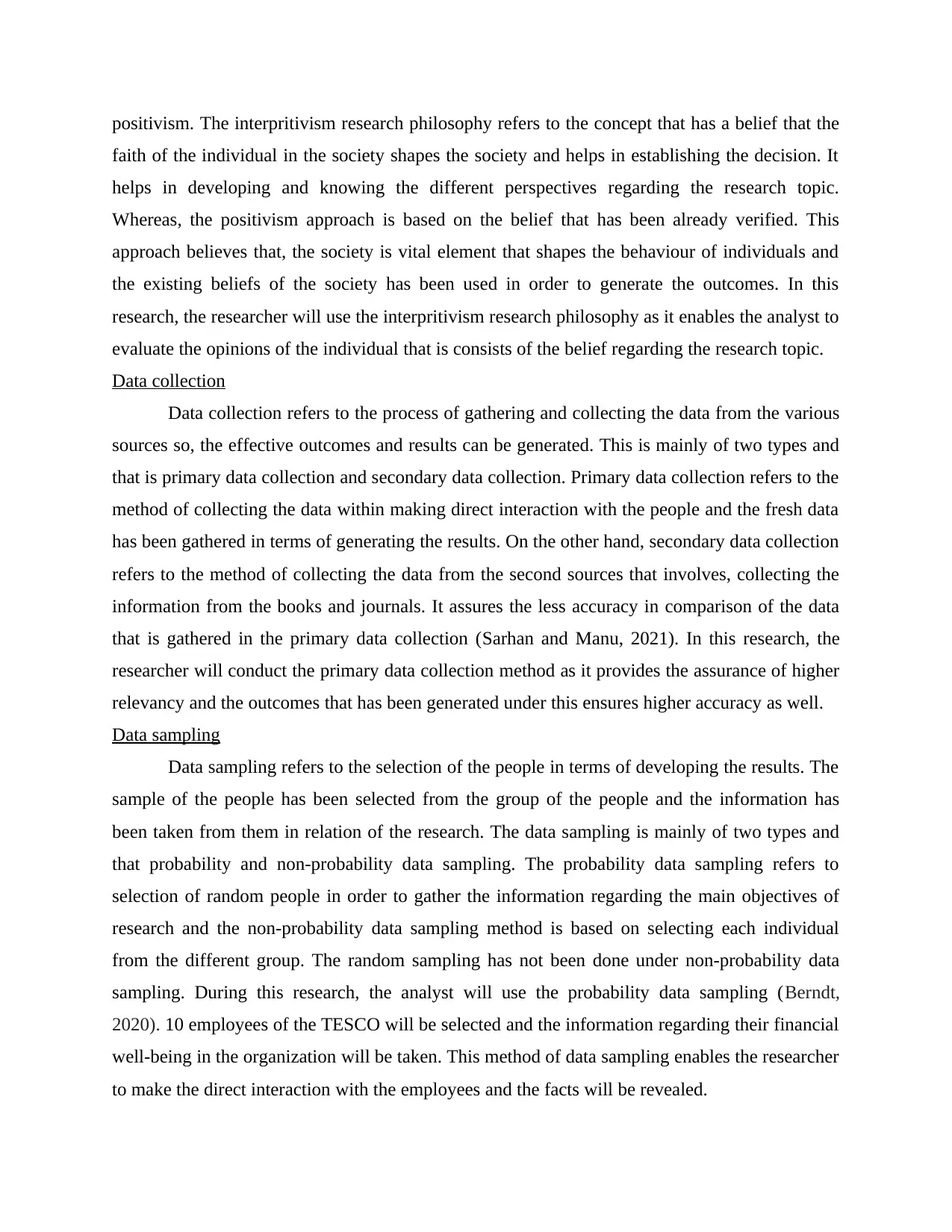
positivism. The interpritivism research philosophy refers to the concept that has a belief that the
faith of the individual in the society shapes the society and helps in establishing the decision. It
helps in developing and knowing the different perspectives regarding the research topic.
Whereas, the positivism approach is based on the belief that has been already verified. This
approach believes that, the society is vital element that shapes the behaviour of individuals and
the existing beliefs of the society has been used in order to generate the outcomes. In this
research, the researcher will use the interpritivism research philosophy as it enables the analyst to
evaluate the opinions of the individual that is consists of the belief regarding the research topic.
Data collection
Data collection refers to the process of gathering and collecting the data from the various
sources so, the effective outcomes and results can be generated. This is mainly of two types and
that is primary data collection and secondary data collection. Primary data collection refers to the
method of collecting the data within making direct interaction with the people and the fresh data
has been gathered in terms of generating the results. On the other hand, secondary data collection
refers to the method of collecting the data from the second sources that involves, collecting the
information from the books and journals. It assures the less accuracy in comparison of the data
that is gathered in the primary data collection (Sarhan and Manu, 2021). In this research, the
researcher will conduct the primary data collection method as it provides the assurance of higher
relevancy and the outcomes that has been generated under this ensures higher accuracy as well.
Data sampling
Data sampling refers to the selection of the people in terms of developing the results. The
sample of the people has been selected from the group of the people and the information has
been taken from them in relation of the research. The data sampling is mainly of two types and
that probability and non-probability data sampling. The probability data sampling refers to
selection of random people in order to gather the information regarding the main objectives of
research and the non-probability data sampling method is based on selecting each individual
from the different group. The random sampling has not been done under non-probability data
sampling. During this research, the analyst will use the probability data sampling (Berndt,
2020). 10 employees of the TESCO will be selected and the information regarding their financial
well-being in the organization will be taken. This method of data sampling enables the researcher
to make the direct interaction with the employees and the facts will be revealed.
faith of the individual in the society shapes the society and helps in establishing the decision. It
helps in developing and knowing the different perspectives regarding the research topic.
Whereas, the positivism approach is based on the belief that has been already verified. This
approach believes that, the society is vital element that shapes the behaviour of individuals and
the existing beliefs of the society has been used in order to generate the outcomes. In this
research, the researcher will use the interpritivism research philosophy as it enables the analyst to
evaluate the opinions of the individual that is consists of the belief regarding the research topic.
Data collection
Data collection refers to the process of gathering and collecting the data from the various
sources so, the effective outcomes and results can be generated. This is mainly of two types and
that is primary data collection and secondary data collection. Primary data collection refers to the
method of collecting the data within making direct interaction with the people and the fresh data
has been gathered in terms of generating the results. On the other hand, secondary data collection
refers to the method of collecting the data from the second sources that involves, collecting the
information from the books and journals. It assures the less accuracy in comparison of the data
that is gathered in the primary data collection (Sarhan and Manu, 2021). In this research, the
researcher will conduct the primary data collection method as it provides the assurance of higher
relevancy and the outcomes that has been generated under this ensures higher accuracy as well.
Data sampling
Data sampling refers to the selection of the people in terms of developing the results. The
sample of the people has been selected from the group of the people and the information has
been taken from them in relation of the research. The data sampling is mainly of two types and
that probability and non-probability data sampling. The probability data sampling refers to
selection of random people in order to gather the information regarding the main objectives of
research and the non-probability data sampling method is based on selecting each individual
from the different group. The random sampling has not been done under non-probability data
sampling. During this research, the analyst will use the probability data sampling (Berndt,
2020). 10 employees of the TESCO will be selected and the information regarding their financial
well-being in the organization will be taken. This method of data sampling enables the researcher
to make the direct interaction with the employees and the facts will be revealed.
⊘ This is a preview!⊘
Do you want full access?
Subscribe today to unlock all pages.

Trusted by 1+ million students worldwide
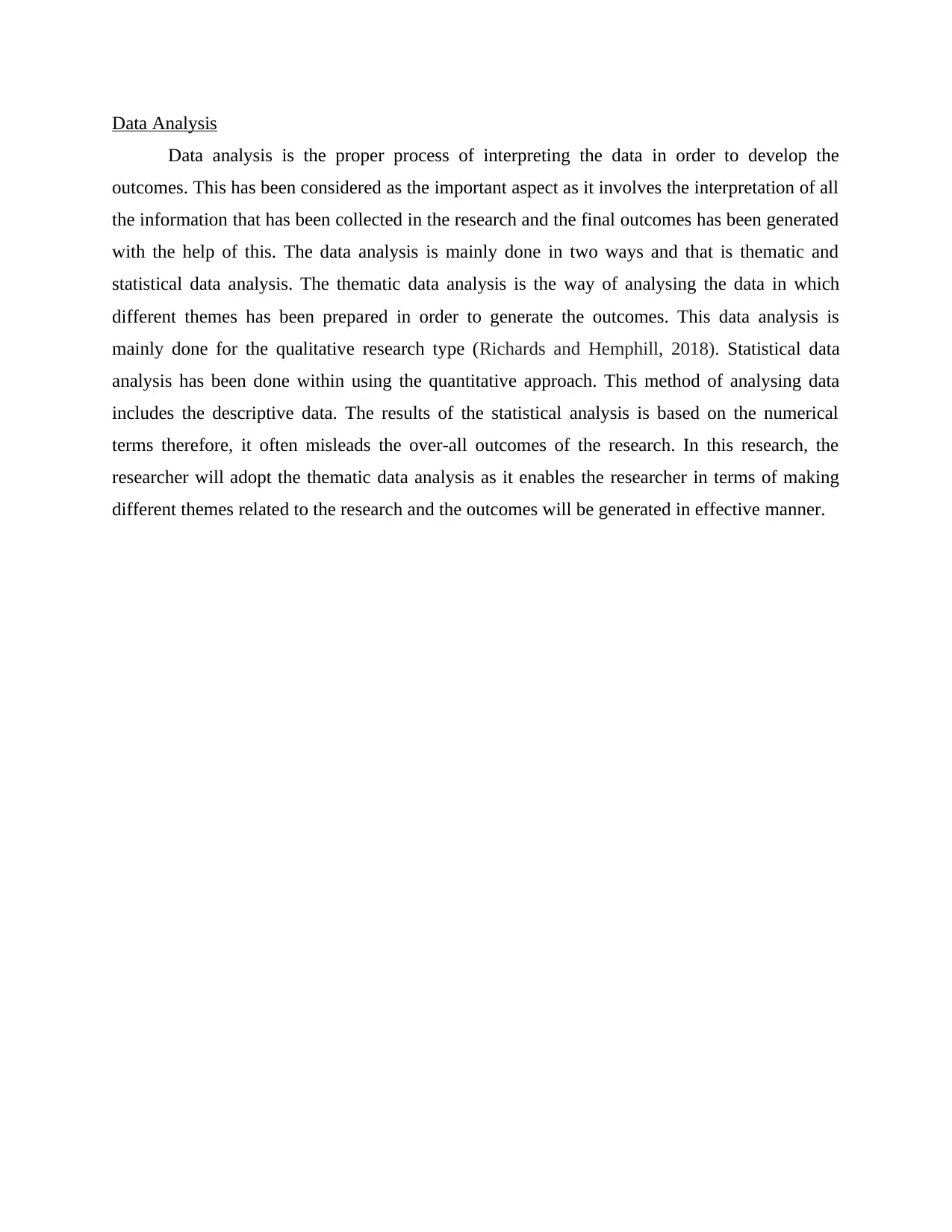
Data Analysis
Data analysis is the proper process of interpreting the data in order to develop the
outcomes. This has been considered as the important aspect as it involves the interpretation of all
the information that has been collected in the research and the final outcomes has been generated
with the help of this. The data analysis is mainly done in two ways and that is thematic and
statistical data analysis. The thematic data analysis is the way of analysing the data in which
different themes has been prepared in order to generate the outcomes. This data analysis is
mainly done for the qualitative research type (Richards and Hemphill, 2018). Statistical data
analysis has been done within using the quantitative approach. This method of analysing data
includes the descriptive data. The results of the statistical analysis is based on the numerical
terms therefore, it often misleads the over-all outcomes of the research. In this research, the
researcher will adopt the thematic data analysis as it enables the researcher in terms of making
different themes related to the research and the outcomes will be generated in effective manner.
Data analysis is the proper process of interpreting the data in order to develop the
outcomes. This has been considered as the important aspect as it involves the interpretation of all
the information that has been collected in the research and the final outcomes has been generated
with the help of this. The data analysis is mainly done in two ways and that is thematic and
statistical data analysis. The thematic data analysis is the way of analysing the data in which
different themes has been prepared in order to generate the outcomes. This data analysis is
mainly done for the qualitative research type (Richards and Hemphill, 2018). Statistical data
analysis has been done within using the quantitative approach. This method of analysing data
includes the descriptive data. The results of the statistical analysis is based on the numerical
terms therefore, it often misleads the over-all outcomes of the research. In this research, the
researcher will adopt the thematic data analysis as it enables the researcher in terms of making
different themes related to the research and the outcomes will be generated in effective manner.
Paraphrase This Document
Need a fresh take? Get an instant paraphrase of this document with our AI Paraphraser
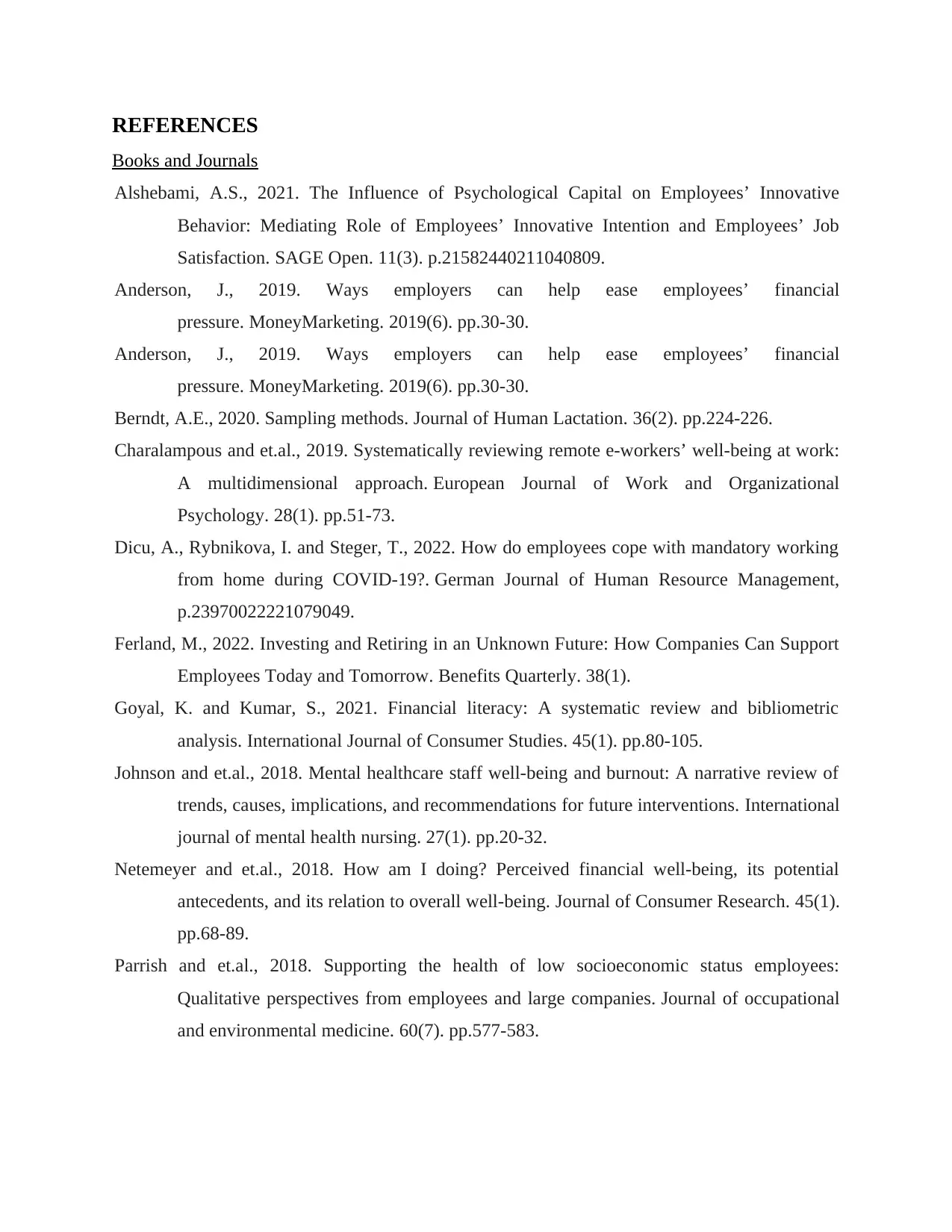
REFERENCES
Books and Journals
Alshebami, A.S., 2021. The Influence of Psychological Capital on Employees’ Innovative
Behavior: Mediating Role of Employees’ Innovative Intention and Employees’ Job
Satisfaction. SAGE Open. 11(3). p.21582440211040809.
Anderson, J., 2019. Ways employers can help ease employees’ financial
pressure. MoneyMarketing. 2019(6). pp.30-30.
Anderson, J., 2019. Ways employers can help ease employees’ financial
pressure. MoneyMarketing. 2019(6). pp.30-30.
Berndt, A.E., 2020. Sampling methods. Journal of Human Lactation. 36(2). pp.224-226.
Charalampous and et.al., 2019. Systematically reviewing remote e-workers’ well-being at work:
A multidimensional approach. European Journal of Work and Organizational
Psychology. 28(1). pp.51-73.
Dicu, A., Rybnikova, I. and Steger, T., 2022. How do employees cope with mandatory working
from home during COVID-19?. German Journal of Human Resource Management,
p.23970022221079049.
Ferland, M., 2022. Investing and Retiring in an Unknown Future: How Companies Can Support
Employees Today and Tomorrow. Benefits Quarterly. 38(1).
Goyal, K. and Kumar, S., 2021. Financial literacy: A systematic review and bibliometric
analysis. International Journal of Consumer Studies. 45(1). pp.80-105.
Johnson and et.al., 2018. Mental healthcare staff well‐being and burnout: A narrative review of
trends, causes, implications, and recommendations for future interventions. International
journal of mental health nursing. 27(1). pp.20-32.
Netemeyer and et.al., 2018. How am I doing? Perceived financial well-being, its potential
antecedents, and its relation to overall well-being. Journal of Consumer Research. 45(1).
pp.68-89.
Parrish and et.al., 2018. Supporting the health of low socioeconomic status employees:
Qualitative perspectives from employees and large companies. Journal of occupational
and environmental medicine. 60(7). pp.577-583.
Books and Journals
Alshebami, A.S., 2021. The Influence of Psychological Capital on Employees’ Innovative
Behavior: Mediating Role of Employees’ Innovative Intention and Employees’ Job
Satisfaction. SAGE Open. 11(3). p.21582440211040809.
Anderson, J., 2019. Ways employers can help ease employees’ financial
pressure. MoneyMarketing. 2019(6). pp.30-30.
Anderson, J., 2019. Ways employers can help ease employees’ financial
pressure. MoneyMarketing. 2019(6). pp.30-30.
Berndt, A.E., 2020. Sampling methods. Journal of Human Lactation. 36(2). pp.224-226.
Charalampous and et.al., 2019. Systematically reviewing remote e-workers’ well-being at work:
A multidimensional approach. European Journal of Work and Organizational
Psychology. 28(1). pp.51-73.
Dicu, A., Rybnikova, I. and Steger, T., 2022. How do employees cope with mandatory working
from home during COVID-19?. German Journal of Human Resource Management,
p.23970022221079049.
Ferland, M., 2022. Investing and Retiring in an Unknown Future: How Companies Can Support
Employees Today and Tomorrow. Benefits Quarterly. 38(1).
Goyal, K. and Kumar, S., 2021. Financial literacy: A systematic review and bibliometric
analysis. International Journal of Consumer Studies. 45(1). pp.80-105.
Johnson and et.al., 2018. Mental healthcare staff well‐being and burnout: A narrative review of
trends, causes, implications, and recommendations for future interventions. International
journal of mental health nursing. 27(1). pp.20-32.
Netemeyer and et.al., 2018. How am I doing? Perceived financial well-being, its potential
antecedents, and its relation to overall well-being. Journal of Consumer Research. 45(1).
pp.68-89.
Parrish and et.al., 2018. Supporting the health of low socioeconomic status employees:
Qualitative perspectives from employees and large companies. Journal of occupational
and environmental medicine. 60(7). pp.577-583.
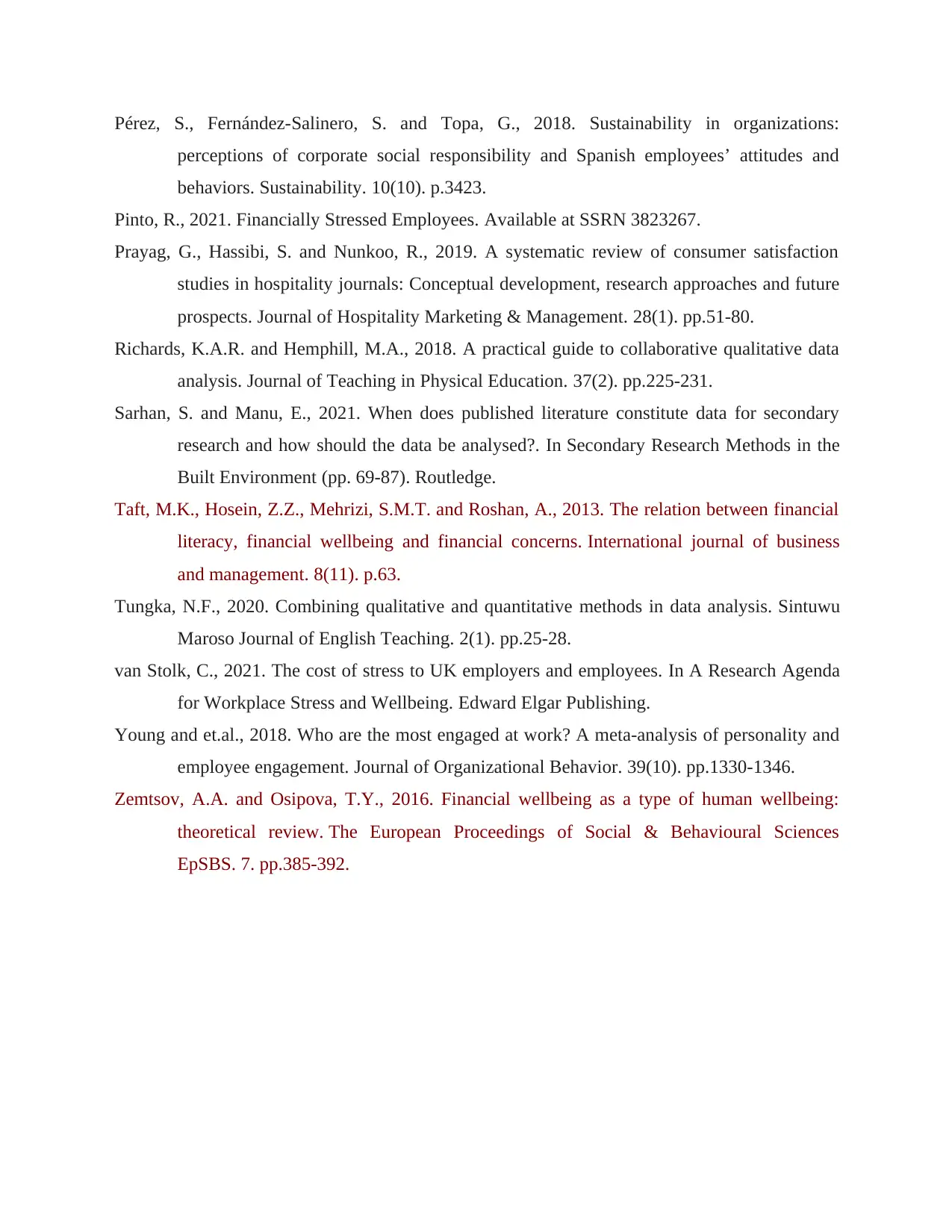
Pérez, S., Fernández-Salinero, S. and Topa, G., 2018. Sustainability in organizations:
perceptions of corporate social responsibility and Spanish employees’ attitudes and
behaviors. Sustainability. 10(10). p.3423.
Pinto, R., 2021. Financially Stressed Employees. Available at SSRN 3823267.
Prayag, G., Hassibi, S. and Nunkoo, R., 2019. A systematic review of consumer satisfaction
studies in hospitality journals: Conceptual development, research approaches and future
prospects. Journal of Hospitality Marketing & Management. 28(1). pp.51-80.
Richards, K.A.R. and Hemphill, M.A., 2018. A practical guide to collaborative qualitative data
analysis. Journal of Teaching in Physical Education. 37(2). pp.225-231.
Sarhan, S. and Manu, E., 2021. When does published literature constitute data for secondary
research and how should the data be analysed?. In Secondary Research Methods in the
Built Environment (pp. 69-87). Routledge.
Taft, M.K., Hosein, Z.Z., Mehrizi, S.M.T. and Roshan, A., 2013. The relation between financial
literacy, financial wellbeing and financial concerns. International journal of business
and management. 8(11). p.63.
Tungka, N.F., 2020. Combining qualitative and quantitative methods in data analysis. Sintuwu
Maroso Journal of English Teaching. 2(1). pp.25-28.
van Stolk, C., 2021. The cost of stress to UK employers and employees. In A Research Agenda
for Workplace Stress and Wellbeing. Edward Elgar Publishing.
Young and et.al., 2018. Who are the most engaged at work? A meta‐analysis of personality and
employee engagement. Journal of Organizational Behavior. 39(10). pp.1330-1346.
Zemtsov, A.A. and Osipova, T.Y., 2016. Financial wellbeing as a type of human wellbeing:
theoretical review. The European Proceedings of Social & Behavioural Sciences
EpSBS. 7. pp.385-392.
perceptions of corporate social responsibility and Spanish employees’ attitudes and
behaviors. Sustainability. 10(10). p.3423.
Pinto, R., 2021. Financially Stressed Employees. Available at SSRN 3823267.
Prayag, G., Hassibi, S. and Nunkoo, R., 2019. A systematic review of consumer satisfaction
studies in hospitality journals: Conceptual development, research approaches and future
prospects. Journal of Hospitality Marketing & Management. 28(1). pp.51-80.
Richards, K.A.R. and Hemphill, M.A., 2018. A practical guide to collaborative qualitative data
analysis. Journal of Teaching in Physical Education. 37(2). pp.225-231.
Sarhan, S. and Manu, E., 2021. When does published literature constitute data for secondary
research and how should the data be analysed?. In Secondary Research Methods in the
Built Environment (pp. 69-87). Routledge.
Taft, M.K., Hosein, Z.Z., Mehrizi, S.M.T. and Roshan, A., 2013. The relation between financial
literacy, financial wellbeing and financial concerns. International journal of business
and management. 8(11). p.63.
Tungka, N.F., 2020. Combining qualitative and quantitative methods in data analysis. Sintuwu
Maroso Journal of English Teaching. 2(1). pp.25-28.
van Stolk, C., 2021. The cost of stress to UK employers and employees. In A Research Agenda
for Workplace Stress and Wellbeing. Edward Elgar Publishing.
Young and et.al., 2018. Who are the most engaged at work? A meta‐analysis of personality and
employee engagement. Journal of Organizational Behavior. 39(10). pp.1330-1346.
Zemtsov, A.A. and Osipova, T.Y., 2016. Financial wellbeing as a type of human wellbeing:
theoretical review. The European Proceedings of Social & Behavioural Sciences
EpSBS. 7. pp.385-392.
⊘ This is a preview!⊘
Do you want full access?
Subscribe today to unlock all pages.

Trusted by 1+ million students worldwide
1 out of 13
Related Documents
Your All-in-One AI-Powered Toolkit for Academic Success.
+13062052269
info@desklib.com
Available 24*7 on WhatsApp / Email
![[object Object]](/_next/static/media/star-bottom.7253800d.svg)
Unlock your academic potential
Copyright © 2020–2025 A2Z Services. All Rights Reserved. Developed and managed by ZUCOL.





